The Fox and the Cat
The Fox and the Cat (Italian: Il gatto e la volpe, the names' sequence is reversed as gatto means 'cat' and volpe means 'fox') are a pair of fictional characters who appear as the main antagonists in the 1883 book The Adventures of Pinocchio (Le avventure di Pinocchio) by Italian writer Carlo Collodi. Both are depicted as con-men, who lead Pinocchio astray and unsuccessfully attempt to murder him.[1] The pair pretend to sport disabilities; the Fox lameness and the Cat blindness. The Fox is depicted as the more intelligent of the two, with the Cat usually limiting itself to repeating the Fox's words. The Fox and The Cat served as the main antagonists of the story.
| The Fox and the Cat | |
|---|---|
| The Adventures of Pinocchio characters | |
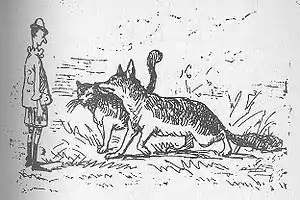 The Fox and the Cat as drawn by Enrico Mazzanti | |
| First appearance | The Adventures of Pinocchio |
| Created by | Carlo Collodi |
| In-universe information | |
| Species | Fox (The Fox) Cat (The Cat) |
| Gender | Male (original story) |
| Occupation | Con artists |
| Nationality | Italian |
Role in the book
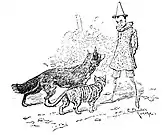
Pinocchio encounters the two after leaving Mangiafuoco's theatre with five gold coins, whereupon the Fox claims to know Pinocchio's father Mister Geppetto and proposes to Pinocchio to visit the Land of Barn Owls (Paese dei Barbagianni) and thence to a 'Field of Miracles' (Il campo dei Miracoli), where coins can be grown into a money-producing tree. A white blackbird warns Pinocchio against these lies, but is eaten by the Cat. The Fox covers up this action by claiming that the blackbird talks too much. The pair lead Pinocchio to the Red Lobster Inn (Osteria del Gambero Rosso), where they eat a large meal and ask to be awoken at midnight.
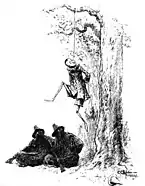
Two hours before the set time, the pair abandon Pinocchio to pay for the meal with one of his coins, and have the innkeeper leave a message for Pinocchio that the Cat's eldest kitten had fallen ill, and that they would meet Pinocchio at the Field of Miracles later. When Pinocchio leaves the inn, the two attack him in the guise of murderers and in the ensuing struggle, Pinocchio bites off the Cat's paw. The murderers then hang Pinocchio from a tree, which he escapes with the assistance of The Fairy with Turquoise Hair, who enlisted a falcon to cut him down.
The next day, Pinocchio encounters the pair again, unaware that they are the murderers who tried to hang him. When Pinocchio notices the Cat's paw in a sling, the Fox claims that the Cat cut it off to feed a starving wolf. They lead Pinocchio to the town of Catchfools (Acchiappacitrulli), where the coins are soon buried. In Pinocchio's absence, the pair dig up the coins and escape. Pinocchio learns of this from a parrot, who mocks him for falling for their tricks.
Near the end of the book, Pinocchio encounters the Fox and the Cat again when looking for a place for Geppetto to recuperate. This time, the pair have become impoverished, whereas the Fox is now truly lame, nearly hairless, and tailless (the Fox had to chop off his own tail to sell for money), and the Cat truly blind. They plead for food or money, but are rebuffed by Pinocchio while stating that it serves them right for their wickedness. He then leaves, all the while saying goodbye to his 'false friends'.
Portrayals in popular culture
Honest John and Gideon (Disney)

In the 1940 Disney film Pinocchio, the Fox and the Cat are given the names John Worthington Foulfellow (or "Honest John"; voiced by Walter Catlett) and Gideon (whose hiccups were provided by Mel Blanc and whose mute comic hijinks were modeled on Harpo Marx, the silent member of The Marx Brothers).[2][3][4][5][6][7] The pair differ from the original characters in a number of ways; they do not feign disability and they persuade Pinocchio to join the puppet show (instead of Pinocchio discovering it himself) as well as go to Pleasure Island, upon being hired to do by The Coachman.[8] They also do not attempt to murder Pinocchio, although Foulfellow suggests to the Coachman in one scene that they would be willing to murder if required as part of a job. The Field of Miracles subplot is also absent from the film. Foulfellow is portrayed as an eccentric ham actor who appears to be illiterate, whereas Gideon is portrayed as a foolish mute who frequently gets Foulfellow into trouble on accident. Apart from three hiccups, Gideon is mute throughout the film. A draft script of the film had Foulfellow and Gideon being arrested by the police after encountering Pinocchio a third time, but this scene was written out of the film's final draft for unknown reasons. The characters were considered to be used again in the Disney film Fun and Fancy Free (1947) as the owners of the Magic Beans that Mickey Mouse acquires in exchange for his cow, but the idea was dropped.[9]
In the video game of Pinocchio, Foulfellow appears as an enemy during the first stage. The duo were also planned to make an appearance in the RPG video game Kingdom Hearts 358/2 Days (2009), but were cut for space restrictions.
In the Disney book Pinocchio's Promise, Foulfellow and Gideon see Pinocchio walking into town to give a cuckoo clock to Geppetto's friend Mrs. Ramono, whereupon he is diverted to a circus. Foulfellow attempts to sell the clock elsewhere, while Gideon takes Pinocchio to the circus with two expired tickets, but abandons the boy when the latter is scolded by the admission attendant. After Pinocchio leaves the circus and reports Foulfellow's trickery to the local police, Foulfellow is then arrested and Pinocchio gives the clock to Mrs. Ramono.
In a Disney book adaption of the tale The Emperor's New Clothes, Foulfellow and Gideon - posing as tailors - trick the emperor (portrayed in the same book by Prince John).
Gideon and Foulfellow also appear in the fifth installment of the book series The Kingdom Keepers. They are featured as members of the Disney Villains legion known as the Overtakers, and battle Finn in chapter six of Shell Game.
In other media
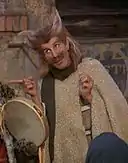
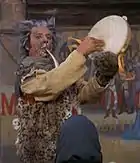
- In the 1947 Italian live action film Le avventure di Pinocchio, the Fox and the Cat are portrayed by Angelo Taddeoli and Pietro Tommei.
- They are featured in the 1952 animes series Piccolino no Bōken
- In the 1959 Soviet animated film The Adventures of Buratino they are named Alice the Fox and Basilio the Cat and voiced in the original version by Elena Ponsova and Vladimir Lepko respectively.
- In the 1960–61 television adaptation by Rankin/Bass Productions, The New Adventures of Pinocchio, the Fox and the Cat were named Foxy Q. Fibble and Cool S. Cat, and voiced by Larry D. Mann and Paul Kligman.
- The Fox and the Cat appeared in the 1972 miniseries The Adventures of Pinocchio, portrayed by Ciccio Ingrassia and Franco Franchi. They are depicted as humans who work as comedians for Mangiafuoco, wearing makeup as a fox and a cat; later they are fired, and try to steal Pinocchio's coins.
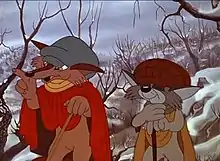
- In the 1972 animated film The Adventures of Pinocchio (directed by Giuliano Cenci), the Fox and the Cat (voiced by Sergio Tedesco and Manlio De Angelis in the Italian version, and by Alan Sues and Don Messick in the English dub) follow the characterization shown in the book: the pair pretend to be physically disabled, and tempt Pinocchio to the Field of Miracles. As in the book, the Fox is the more articulate of the two, and the Pair attempt to murder Pinocchio for his coins, though the Cat does not lose his paw as his book counterpart does. At the end of the film, the two are impoverished, though the Fox does not lose his tail nor any of his fur as in the book.
- In Pinocchio: The Series (1972), the Fox is named Jack, while the cat was replaced with a weasel named Willie.
- The Fox and the Cat are the primary antagonists of another Rankin/Bass adaptation, Pinocchio's Christmas (1980), voiced by Allen Swift (who was impersonating Claude Rains) and Pat Bright. They had previously made 'friends' with Pinocchio and taught him many of his bad habits. They do not feign disability and the Cat is female, which is how it is in the book. While they did a trick similar to the Field of Miracles to Pinocchio, which involved a Christmas tree growing at sunset from some coins, they just said that the tree failed to grow. The Fox and the Cat try to sell Pinocchio to a sleigh driver who works for a rich duke who will give Pinocchio to his children. When Lady Azora looks into Pinocchio's future and mentions that he will led astray on his path to becoming a real boy, Pinocchio catches a glimpse of the Fox and the Cat waving at him.
- In the 1996 live action film The Adventures of Pinocchio (directed by Steve Barron), the Fox and the Cat (portrayed by Rob Schneider and Bebe Neuwirth, respectively) are named Volpe ('dox' in Italian) and Felinet, and are portrayed as humans in league with Mangiafuoco (named Lorenzini, in this adaptation). In a reversal of roles, Felinet is female and takes on the more dominant role, while Volpe is a bungling sidekick. They appear at their first encounter with Pinocchio, from whom Geppetto takes away, while telling Volpe and Felinet that Pinocchio will only play with his own sort. Volpe and Felinet later witness Pinocchio causing mischievous havoc in a bakery, even when the police arrive. As in the novel, the pair trick Pinocchio into giving up his coins by taking him to the Field of Miracles (depicted near a monastery), where they steal the money. In conclusion, they are tricked by Pinocchio into drinking cursed water (where Pinocchio claims that the water will enable them to turn white stones into gold) which transforms them into a real fox and cat, off-screen. They are shown to have been captured by a farmer and kept as pets, where they later witness Pinocchio in town. When Volpe quotes "Don't you just hate that kid", Felinet quotes "Not as much as I hate you."
- The Fox and the Cat were featured in the Happily Ever After: Fairy Tales for Every Child version of Pinocchio. where they were referred to as Redd Foxx (voiced by Barry Douglas) and Sporty the Cat (voiced by Franklyn Ajaye).
- The Fox and the Cat were also featured in the 2002 film Pinocchio, where they were played by comedy duo Fichi d'India (Bruno Arena and Max Cavallari) in the Italian version, and their English-dubbed voices were provided by Cheech Marin and Eddie Griffin. Like some of the animal characters depicted in this film, here they are depicted as humans while sporting pointy ears and fangs. They trick Pinocchio into digging his coins in the Meadow of Miracles outside of Grabadimwit, but are not seen again after seizing Pinocchio's coins.
- In Pinocchio 3000, the characters Cab and Rodo (voiced by Matt Holland and Jack Daniel Wells) are two robots, based on the Fox and the Cat; they are owned by Mayor Scamboni's daughter Marlene.
- The Fox and the Cat appear in the 2008 television film Pinocchio, portrayed by Toni Bertorelli and Francesco Pannofino.
- The Fox and the Cat appear in the 2012 film Pinocchio, voiced by Mariccia Affiato and Maurizio Micheli in the Italian version, and by Sonja Ball and Thor Bishopric in the Canadian English dub. In this version, the Fox is female and the Cat is male, which is a great reversal from the book. In the American release (2018), they are renamed Trixie the Fox and Leo the Cat (voiced by Ambyr Childers and Jon Heder respectively).
- The Fox and the Cat appear in the 2019 film Pinocchio, portrayed by Massimo Ceccherini and Rocco Papaleo, while their English dub voices are provided by Luigi Scribani and Vladimiro Conti. Like the 2002 film, they are depicted as humans while sporting pointy ears, fangs, and claws. At the end of the film, they are badly reduced and no longer falsely disabled.
- In the 2021 stop-motion Netflix film Pinocchio that is to be written, produced, and directed by Guillermo del Toro, the Fox and the Cat will be voiced by Christoph Waltz.
Notes
Often the 'Field of the Miracles' has been mistaken for the poetic phrase Square of the Miracles, used since the second half of the 20th century to describe the Piazza del Duomo of Pisa. The monuments of the famous square had been called miracles by Gabriele D'Annunzio in his book Forse Che Sì, Forse Che No (1910). Due to everal famous squares in Italy being called campo, and the story of Pinocchio being widespread in the world, many people - in and outside Italy - tend to confuse the two.
References
- Rich, Nathaniel (2011-10-24). "Carlo Collodi's Pinocchio: Why is the original Pinocchio subjected to such sadistic treatment?". Slate.com. Retrieved 2015-07-01.
- Clarke, James (2012-09-30). Animated Films - Virgin Film - James Clarke. ISBN 9781448132812. Retrieved 2015-07-02.
- Harrington, Seán J. (9 February 2015). The Disney Fetish - Seán J. Harrington. ISBN 9780861969081. Retrieved 2015-07-02.
- Lenburg, Jeff (2006). Who's who in Animated Cartoons: An International Guide to Film & Television ... - Jeff Lenburg. ISBN 9781557836717. Retrieved 2015-07-02.
- Brode, Douglas (2009-01-27). Multiculturalism and the Mouse: Race and Sex in Disney Entertainment - Douglas Brode. ISBN 9780292783300. Retrieved 2015-07-02.
- Functions of the Fantastic: Selected Essays from the Thirteenth ... - Joseph L. Sanders. 1995. ISBN 9780313295218. Retrieved 2015-07-02.
- "Disney Theatrical Animated Features - Edited by Paul Muljadi". Retrieved 2015-07-02.
- Davis, Amy M. (2014-01-31). Handsome Heroes and Vile Villains: Masculinity in Disney's Feature Films - Amy M. Davis -. ISBN 9780861969074. Retrieved 2015-07-02.
- "The story behind Fun and Fancy Free", Disney VHS, 1997
Bibliography
- Carlo Collodi, Le Avventure di Pinocchio 1883, RCS MediaGroup